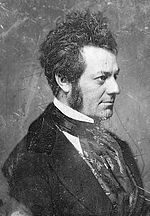The Astor Place Riot

Recently we have been running a series in Off the Grid on the Village as the birthplace of modern drama. NoHo has its own history with drama, and as it turns out, it’s a violent one. In 1849 the Astor Place Riot took place in front of what is today 21 Astor Place, then the site of the Astor Opera House. Also referred to as the Shakespeare Riots, this violent event was sparked by an intense rivalry between two well-known actors of the time, but was inflamed by brewing tensions between New York’s upper class and working class.
On May 7, 1849, three days before the Astor Place Riot, the well-known British actor William Charles Macready took the stage at the Astor Opera House for a production of Macbeth, with an audience consisting primarily of working-class New Yorkers. Hissing and jeers as well as an onslaught of rotten eggs, potatoes, lemons, apples and copper coins greeted the actor and stage company; the outrage escalated from there to one of the red plush chairs being thrown into the orchestra from the second tier. Macready left the theater part way through the production and out a back door. Outraged, he threatened to catch the next ship back to England. While such disturbances during theatrical performances were commonplace in New York (so much so that this incident was dismissed by The New York Herald), what ensued afterward was not.
At the heart of this incident, and the riot to follow, were several factors. First was the rivalry between Macready and the American actor Edwin Forrest. While both were Shakespearean actors, their styles were quite different, and a feud between the two developed and escalated over the years. This conflict was eagerly followed by the press and the public alike (a 19th century version of The Real Housewives of sorts). In the popular imagination, this rivalry transcended acting and was reflective of the class divisions in urban America. Macready was identified with England and its aristocracy and thus embraced by the upper class of New York. Working-class native-born and Irish immigrant New Yorkers, usually at odds, found common ground in their appreciation of Edwin Forrest and disdain for the elite and Macready.


The two thoroughfares surrounding Astor Opera House — Broadway to the west and the Bowery to the east — also reflected this class division: the western one catering to the upper class, and the eastern one more recently catering to the working class or Boweryites. These avenues converged at Astor Place, and it was here that the exclusive Astor Opera House was constructed in 1847, intended for the well-heeled of New York. The Opera House required a dress code for its patrons, intended to discourage Boweryites from attending.
So while the Herald dismissed the event of May 7th, New York’s upper class did not. They took it as an affront by the working class which would not be tolerated. In a joint letter, some 47 of New York’s most prominent citizens, including Herman Melville and Washington Irving, wrote a letter to Macready urging him to return and perform Macbeth on May 10th with the promise of order and protection. Additionally, they had this letter published in the newspapers as further challenge to the Boweryites. Macready accepted the offer, and this group went to the newly elected Mayor Caleb S. Woodhull insisting on police presence for his upcoming performance at the Astor Opera House. The NYC police chief informed the Mayor that the City lacked the force to subdue a serious riot. Fearing chaos on only his second day in office, Mayor Woodhull called on the 27th Regiment of the State’s militia to be stationed at Washington Square Park.
In response to this challenge, Boweryites mobilized as well, buying tickets to the performance and distributing flyers throughout the city calling on workmen to “express their opinions this night at the English Aristocratic Opera House!” On the evening of the scheduled performance, anti-Macready forces disrupted the performance and the police made their way through the audience arresting protesters. Outside the theater the crowd swelled to 10,000 and began hurling stones through windows. The police were quickly overwhelmed and the militia was called in. Shots were fired, first in the air and then into the crowd while pushing the protesters north.

In the end, at least 18 lay dead, mostly bystanders, and by the end of the week four more would die. 150 were wounded or injured, and 177 were arrested, in what was the largest civil disturbance in New York at the time. The following day, a mass rally at City Hall was held but when they made their way up to Astor Place, the crowd was dispersed when the militia leveled their muskets. Thereafter the opera house was known as the Massacre Opera House, a reputation it would not survive. The elite would have its new opera house at the Academy of Music by Union Square, away from the working class area of the Bowery, while the former opera house would close, later housing the New York Mercantile Library.


One response to “The Astor Place Riot”